一、MyBatis架构及主要组件
1、基本架构
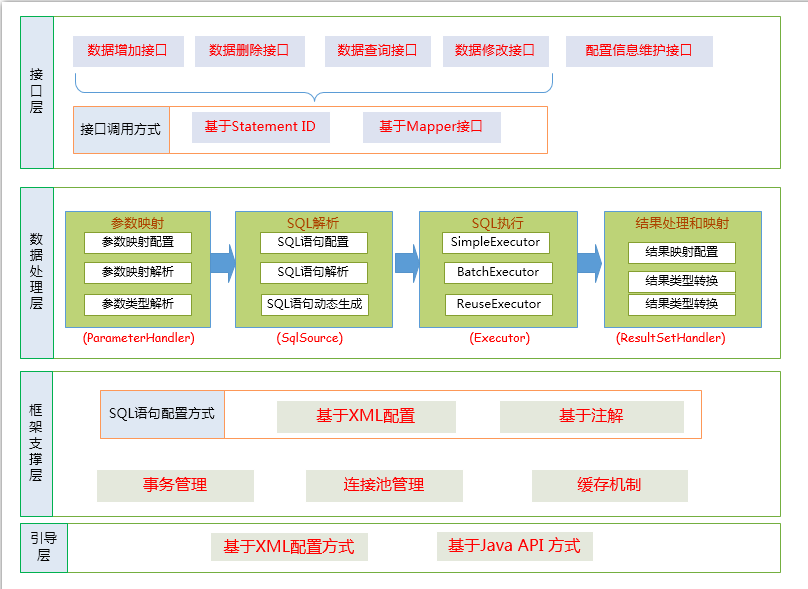
mybatis架构四层作用
- Api接口层:提供API 增加、删除、修改、查询等接口,通过API接口对数据库进行操作。
- 数据处理层:主要负责SQL的 查询、解析、执行以及结果映射的处理,主要作用解析sql根据调用请求完成一次数据库操作.
- 框架支撑层:负责通用基础服务支撑,包含事务管理、连接池管理、缓存管理等共用组件的封装,为上层提供基础服务支撑.
- 引导层:引导层是配置和启动MyBatis 配置信息的方式
2、组件及调用关系
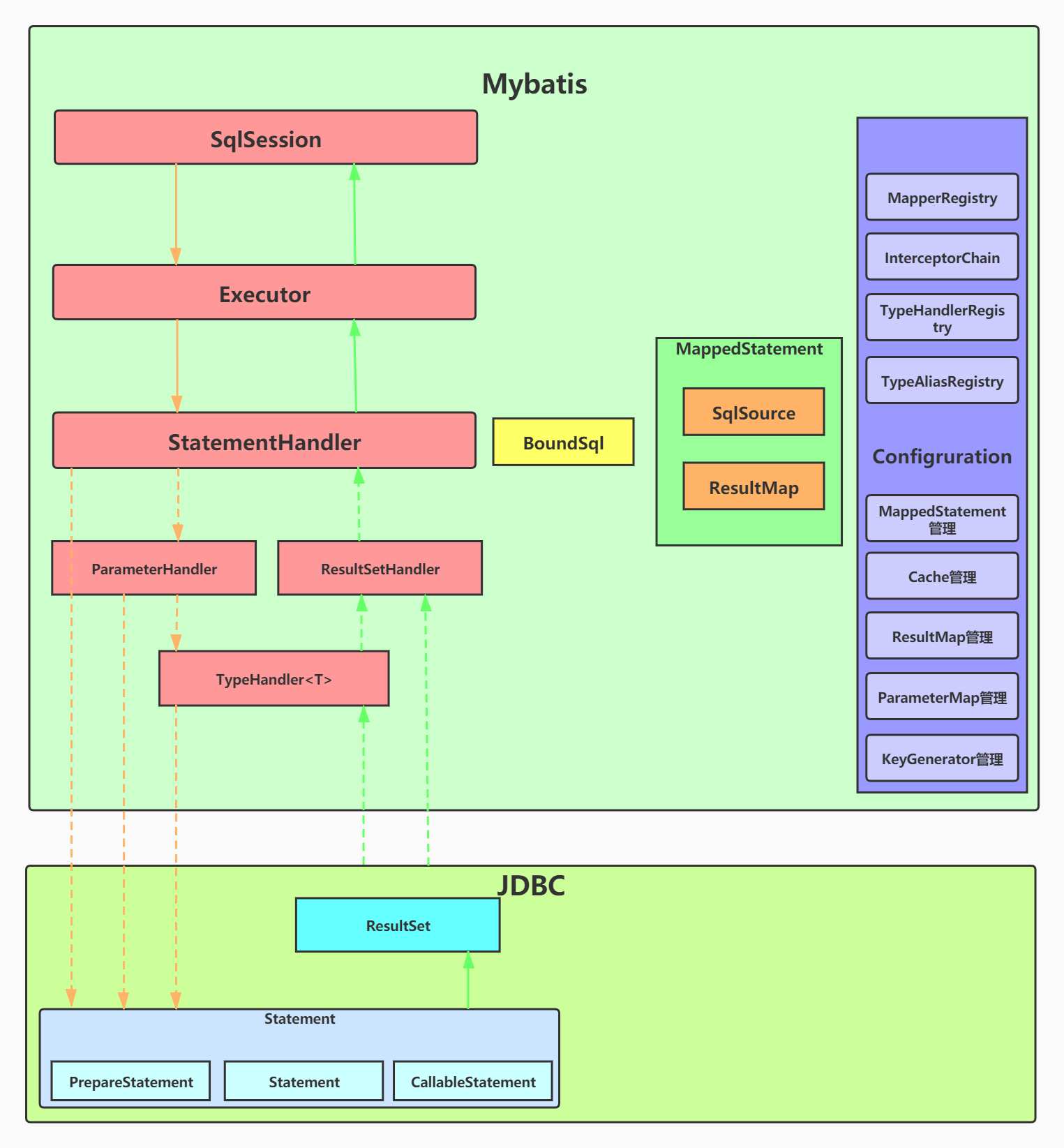
全局配置类 + MyBatis 四大组件 + sqlSession 四大对象 + 映射器三大组成部分
SqlSession:是Mybatis对外暴露的核心API,提供了对数据库的DRUD操作接口。Executor:执行器,由SqlSession调用,负责数据库操作以及Mybatis两级缓存的维护StatementHandler:封装了JDBC Statement操作,负责对Statement的操作,例如PrepareStatement参数的设置以及结果集的处理。ParameterHandler:是StatementHandler内部一个组件,主要负责对ParameterStatement参数的设置ResultSetHandler:是StatementHandler内部一个组件,主要负责对ResultSet结果集的处理,封装成目标对象返回TypeHandler:用于Java类型与JDBC类型之间的数据转换,ParameterHandler和ResultSetHandler会分别使用到它的类型转换功能MappedStatement:是对Mapper配置文件或Mapper接口方法上通过注解申明SQL的封装Configuration:Mybatis所有配置都统一由Configuration进行管理,内部由具体对象分别管理各自的小功能模块
3、全局配置类
Configuration:Mybatis所有配置都统一由Configuration进行管理,内部由具体对象分别管理各自的小功能模块,它不仅是所有配置的载体,同时也是Mybatis的四大对象的创建工具。
4、MyBatis四大组件
Mybatis四大组件构成mybatis的整个生命周期;
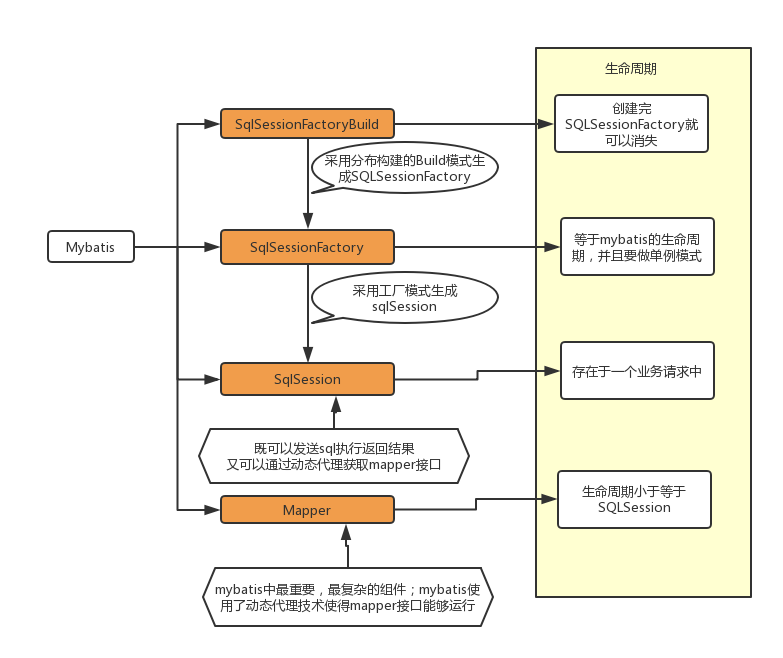
SqlSessionFactoryBuilder(构造器)
会根据配置或者代码来生成 SqlSessionFactory
SqlSessionFactory(工厂接口)
以后他来生成 SqlSession
一般采用单例模式处理它
SqlSession(会话)
一个既可以发送SLQ执行返回结果,也可以获取Mapper的接口
SqlSession 是一个会话,相当于 JDBC 的一个 Connection 对象,它的生命周期应该是在请求数据库处理事务的程中。它是一个线程不安全的对象,在涉及多线程的时候我们需要特别的当心,操作数据库需要注意其隔离级别、数据库锁等高级特性。每次创建的 SqlSession 都必须及时关闭它,它长期存在就会使数据库连接池的活动资源减少。它存活于一个应用的请求和操作,可以执行多条SQL,保证事务的一致性。
SQL Mapper(映射器)
负责发送SQL 去执行,并返回结果。
5、sqlSession四大对象
sqlSession四大对象,描述SQL执行的流程;
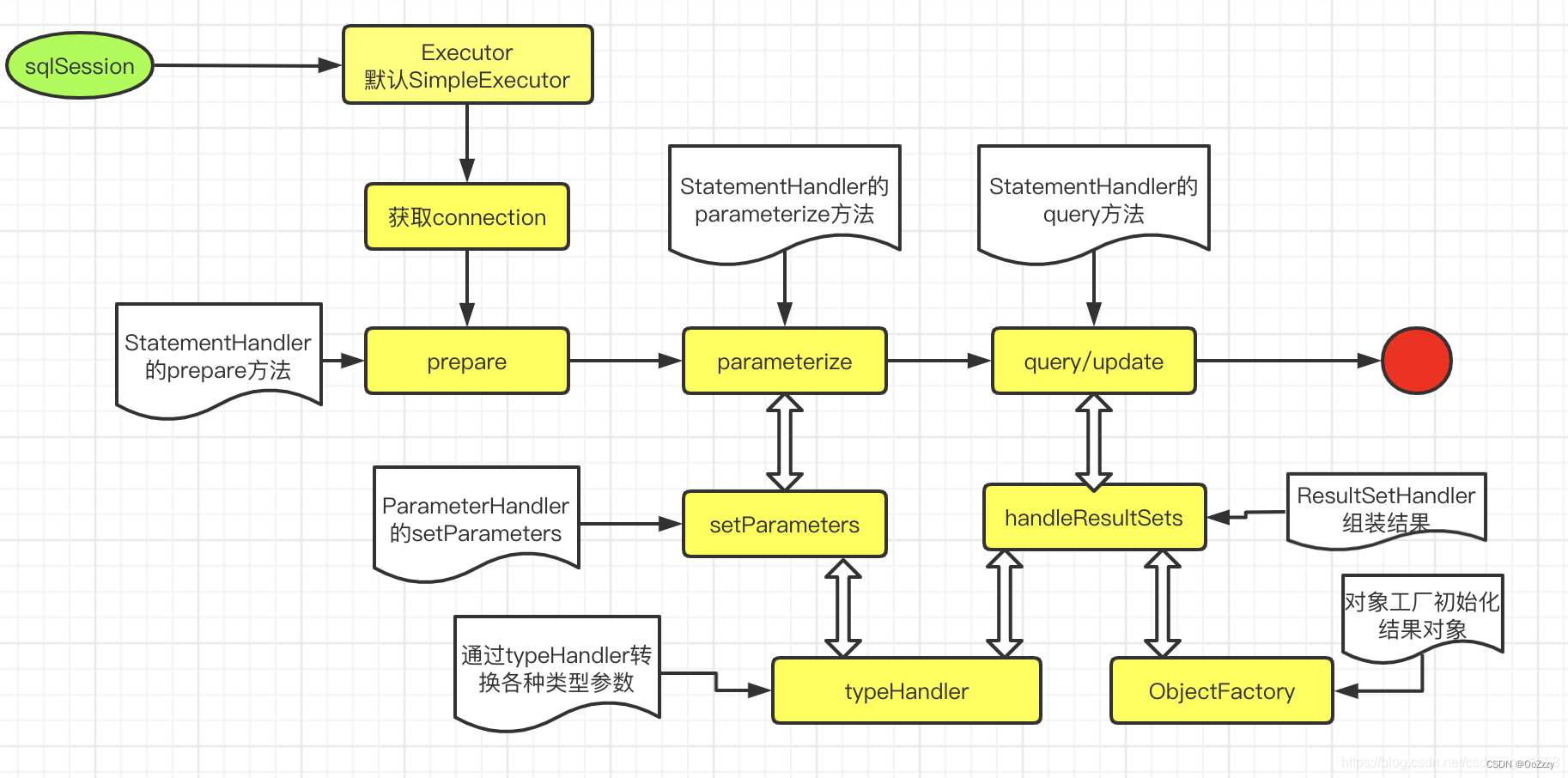
Executor:执行器,由SqlSession调用,负责数据库操作以及Mybatis两级缓存的维护StatementHandler:JDBC处理器,封装了JDBC Statement(Statement是我们平时sql的载体,一条sql代表一个Statement)操作,负责对Statement的操作,例如PrepareStatement参数的设置以及结果集的处理。
ParameterHandler:是StatementHandler内部一个组件,主要负责对ParameterStatement参数的设置ResultSetHandler:是StatementHandler内部一个组件,主要负责对ResultSet结果集的处理,封装成目标对象返回
Executor发起sql执行任务
1、先调用 statementHandler 中的 prepare() 进行SQL的编译
2、然后调用 statementHandler 中的 parameterize() 设置参数
这里其实真正设置参数的是 ParameterHandler 中的 setparameters() 方法,该方法与 typeHandler 进行参数类型的转换。
3、然后执行 query/update 方法,这里使用 ResultSetHandler 进行结果的组装工作
6、映射器三大组成部分
映射器 Mapper 组成部分,描述最底层SQL执行的细节;
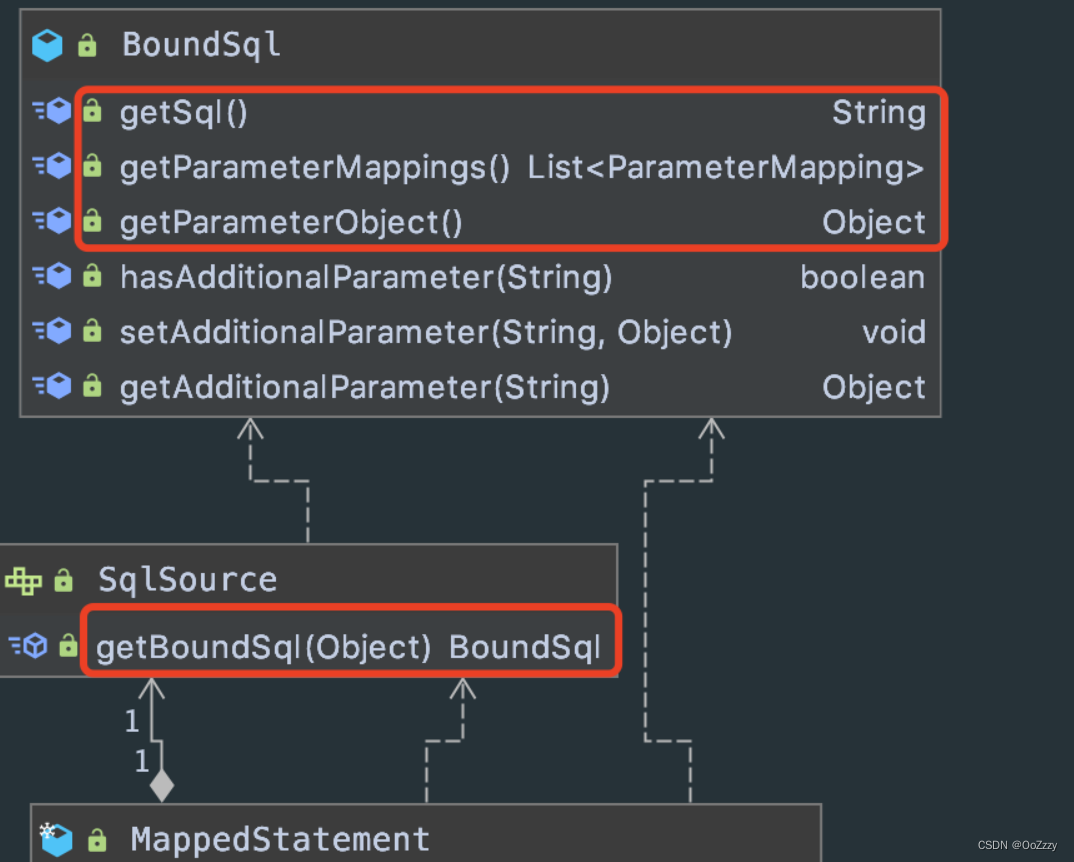
- **
MappedStatement**:sql的ID、缓存信息、resultType、ParameterType、resultMap等信息,是对Mapper配置文件或Mapper接口方法上通过注解申明SQL的封装 - **
Sqlsource**:是MappedStatement的一个属性,是一个接口,主要提供BoundSql BoudSql**:是建立SQL和参数的地方,有三个主要属性,ParameterMappings、ParameterObject和sql,这个对象比较重要,我们通常使用插件就是对它进行拦截;**
二、源码架构及测试代码
1、源码架构
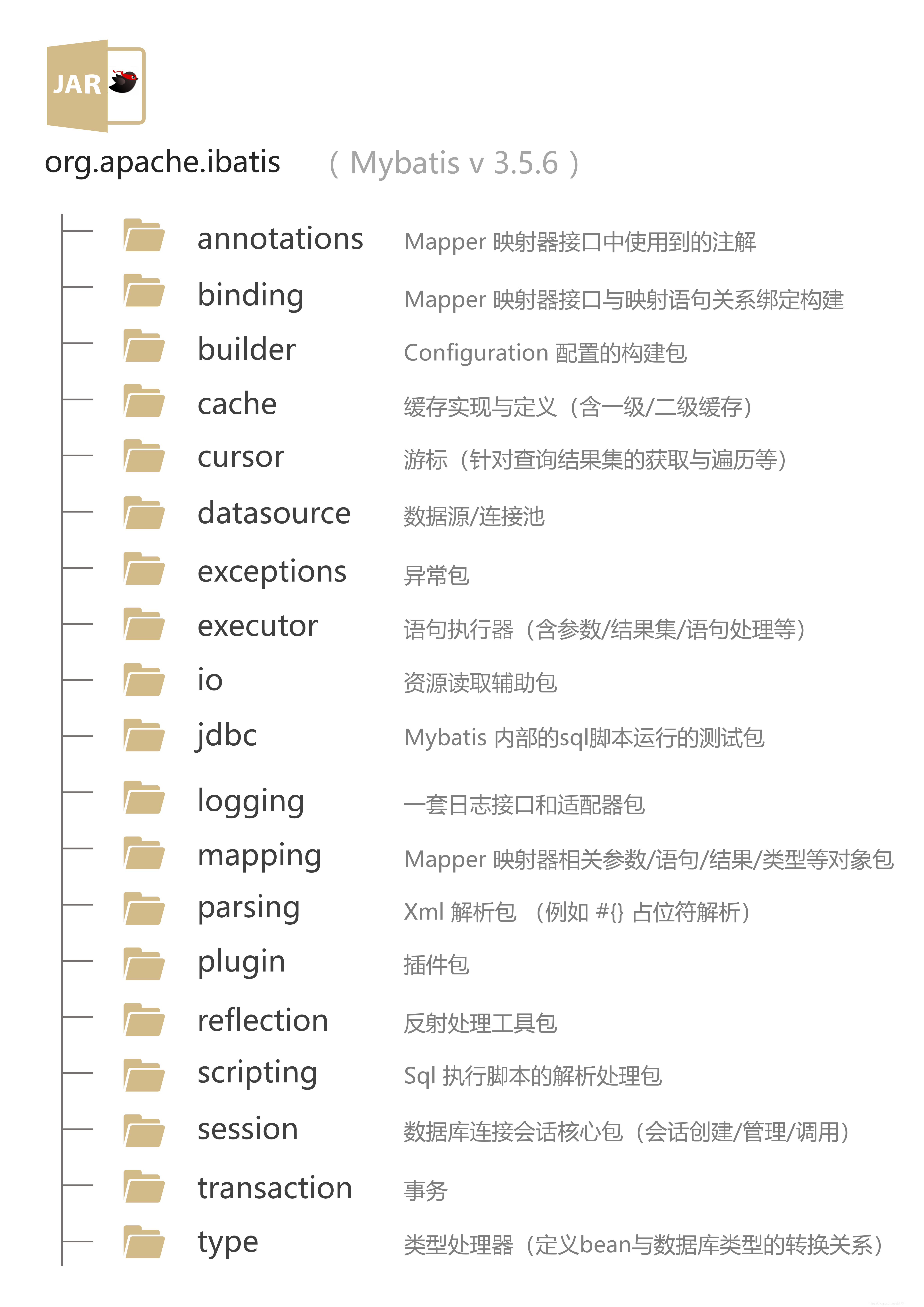
2、测试代码
(1)sqlMapConfig.xml
<?xml version="1.0" encoding="UTF-8" ?>
<!DOCTYPE configuration
PUBLIC "-//mybatis.org//DTD Config 3.0//EN"
"http://mybatis.org/dtd/mybatis-3-config.dtd">
<configuration>
<!--第一部分:数据源配置-->
<environments default="development">
<environment id="development">
<!-- 使用jdbc事务管理 -->
<transactionManager type="JDBC" />
<!-- 数据库连接池 -->
<dataSource type="POOLED">
<property name="driver" value="com.mysql.cj.jdbc.Driver" />
<property name="url"
value="jdbc:mysql:///zdy_mybatis?useSSL=false&characterEncoding=UTF-8&serverTimezone=UTC" />
<property name="username" value="root" />
<property name="password" value="root" />
</dataSource>
</environment>
</environments>
<!--第二部分:引入映射配置文件-->
<mappers>
<mapper resource="mapper/UserMapper.xml"></mapper>
</mappers>
</configuration>(2)UserMapper.xml
<?xml version="1.0" encoding="UTF-8" ?>
<!DOCTYPE mapper
PUBLIC "-//mybatis.org//DTD Mapper 3.0//EN"
"http://mybatis.org/dtd/mybatis-3-mapper.dtd">
<mapper namespace="user">
<select id="findUserById" parameterType="int" resultType="com.itheima.pojo.User">
SELECT id,username FROM user WHERE id = #{id}
</select>
</mapper>(3)编写User类
@Data
public class User {
// ID标识
private Integer id;
// 用户名
private String username;
}(4)编写测试类
public class MybatisTest {
@Test
public void test1() throws IOException {
InputStream resourceAsStream = Resources.getResourceAsStream("SqlMapConfig.xml");
SqlSessionFactory sqlSessionFactory = new SqlSessionFactoryBuilder().build(resourceAsStream);
SqlSession sqlSession = sqlSessionFactory.openSession();
User user = sqlSession.selectOne("user.findUserById", user1);
System.out.println(user);
System.out.println("MyBatis源码环境搭建成功...");
sqlSession.close();
}
}三、全局配置文件解析
1、Configuration对象
mybatis 中最重要的类,用于存储所有的配置,以及 sql
public class Configuration {
protected Environment environment;
// 允许在嵌套语句中使用分页(RowBounds)。如果允许使用则设置为false。默认为false
protected boolean safeRowBoundsEnabled;
// 允许在嵌套语句中使用分页(ResultHandler)。如果允许使用则设置为false
protected boolean safeResultHandlerEnabled = true;
// 是否开启自动驼峰命名规则(camel case)映射,即从经典数据库列名 A_COLUMN
// 到经典 Java 属性名 aColumn 的类似映射。默认false
protected boolean mapUnderscoreToCamelCase;
// 当开启时,任何方法的调用都会加载该对象的所有属性。否则,每个属性会按需加载。默认值false (true in ≤3.4.1)
protected boolean aggressiveLazyLoading;
// 是否允许单一语句返回多结果集(需要兼容驱动)。
protected boolean multipleResultSetsEnabled = true;
// 允许 JDBC 支持自动生成主键,需要驱动兼容。这就是insert时获取mysql自增主键/oracle sequence的开关。
// 注:一般来说,这是希望的结果,应该默认值为true比较合适。
protected boolean useGeneratedKeys;
// 使用列标签代替列名,一般来说,这是希望的结果
protected boolean useColumnLabel = true;
// 是否启用缓存
protected boolean cacheEnabled = true;
// 指定当结果集中值为 null 的时候是否调用映射对象的 setter(map 对象时为 put)方法,
// 这对于有 Map.keySet() 依赖或 null 值初始化的时候是有用的。
protected boolean callSettersOnNulls;
// 允许使用方法签名中的名称作为语句参数名称。 为了使用该特性,你的工程必须采用Java 8编译,
// 并且加上-parameters选项。(从3.4.1开始)
protected boolean useActualParamName = true;
//当返回行的所有列都是空时,MyBatis默认返回null。 当开启这个设置时,MyBatis会返回一个空实例。
// 请注意,它也适用于嵌套的结果集 (i.e. collectioin and association)。(从3.4.2开始)
// 注:这里应该拆分为两个参数比较合适, 一个用于结果集,一个用于单记录。
// 通常来说,我们会希望结果集不是null,单记录仍然是null
protected boolean returnInstanceForEmptyRow;
protected boolean shrinkWhitespacesInSql;
// 指定 MyBatis 增加到日志名称的前缀。
protected String logPrefix;
// 指定 MyBatis 所用日志的具体实现,未指定时将自动查找。一般建议指定为slf4j或log4j
protected Class<? extends Log> logImpl;
// 指定VFS的实现, VFS是mybatis提供的用于访问AS内资源的一个简便接口
protected Class<? extends VFS> vfsImpl;
protected Class<?> defaultSqlProviderType;
// MyBatis 利用本地缓存机制(Local Cache)防止循环引用(circular references)和加速重复嵌套查询。
// 默认值为 SESSION,这种情况下会缓存一个会话中执行的所有查询。
// 若设置值为 STATEMENT,本地会话仅用在语句执行上,对相同 SqlSession 的不同调用将不会共享数据。
protected LocalCacheScope localCacheScope = LocalCacheScope.SESSION;
// 当没有为参数提供特定的 JDBC 类型时,为空值指定 JDBC 类型。 某些驱动需要指定列的 JDBC 类型,
// 多数情况直接用一般类型即可,比如 NULL、VARCHAR 或 OTHER。
protected JdbcType jdbcTypeForNull = JdbcType.OTHER;
// 指定对象的哪个方法触发一次延迟加载。
protected Set<String> lazyLoadTriggerMethods = new HashSet<>(Arrays.asList("equals", "clone", "hashCode", "toString"));
// 设置超时时间,它决定驱动等待数据库响应的秒数。默认不超时
protected Integer defaultStatementTimeout;
// 为驱动的结果集设置默认获取数量。
protected Integer defaultFetchSize;
// SIMPLE 就是普通的执行器;REUSE 执行器会重用预处理语句(prepared statements);
// BATCH 执行器将重用语句并执行批量更新。
protected ResultSetType defaultResultSetType;
// 默认执行器类型
protected ExecutorType defaultExecutorType = ExecutorType.SIMPLE;
// 指定 MyBatis 应如何自动映射列到字段或属性。
// NONE 表示取消自动映射;
// PARTIAL 只会自动映射没有定义嵌套结果集映射的结果集。
// FULL 会自动映射任意复杂的结果集(无论是否嵌套)。
protected AutoMappingBehavior autoMappingBehavior = AutoMappingBehavior.PARTIAL;
// 指定发现自动映射目标未知列(或者未知属性类型)的行为。这个值应该设置为WARNING比较合适
protected AutoMappingUnknownColumnBehavior autoMappingUnknownColumnBehavior = AutoMappingUnknownColumnBehavior.NONE;
// settings下的properties属性
protected Properties variables = new Properties();
// 默认的反射器工厂,用于操作属性、构造器方便
protected ReflectorFactory reflectorFactory = new DefaultReflectorFactory();
// 对象工厂, 所有的类resultMap类都需要依赖于对象工厂来实例化
protected ObjectFactory objectFactory = new DefaultObjectFactory();
// 对象包装器工厂,主要用来在创建非原生对象,比如增加了某些监控或者特殊属性的代理类
protected ObjectWrapperFactory objectWrapperFactory = new DefaultObjectWrapperFactory();
// 延迟加载的全局开关。当开启时,所有关联对象都会延迟加载。特定关联关系中可通过设置fetchType属性来覆盖该项的开关状态
protected boolean lazyLoadingEnabled = false;
// 指定 Mybatis 创建具有延迟加载能力的对象所用到的代理工具。MyBatis 3.3+使用JAVASSIST
protected ProxyFactory proxyFactory = new JavassistProxyFactory(); // #224 Using internal Javassist instead of OGNL
// MyBatis 可以根据不同的数据库厂商执行不同的语句,这种多厂商的支持是基于映射语句中的 databaseId 属性。
protected String databaseId;
/**
* Configuration factory class.
* Used to create Configuration for loading deserialized unread properties.
*
* @see <a href='https://github.com/mybatis/old-google-code-issues/issues/300'>Issue 300 (google code)</a>
*/
protected Class<?> configurationFactory;
protected final MapperRegistry mapperRegistry = new MapperRegistry(this);
// mybatis插件列表
protected final InterceptorChain interceptorChain = new InterceptorChain();
protected final TypeHandlerRegistry typeHandlerRegistry = new TypeHandlerRegistry(this);
// 类型注册器, 用于在执行sql语句的出入参映射以及mybatis-config文件里的各种配置
// 比如<transactionManager type="JDBC"/><dataSource type="POOLED">时使用简写
protected final TypeAliasRegistry typeAliasRegistry = new TypeAliasRegistry();
protected final LanguageDriverRegistry languageRegistry = new LanguageDriverRegistry();
protected final Map<String, MappedStatement> mappedStatements = new StrictMap<MappedStatement>("Mapped Statements collection")
.conflictMessageProducer((savedValue, targetValue) ->
". please check " + savedValue.getResource() + " and " + targetValue.getResource());
protected final Map<String, Cache> caches = new StrictMap<>("Caches collection");
protected final Map<String, ResultMap> resultMaps = new StrictMap<>("Result Maps collection");
protected final Map<String, ParameterMap> parameterMaps = new StrictMap<>("Parameter Maps collection");
protected final Map<String, KeyGenerator> keyGenerators = new StrictMap<>("Key Generators collection");
protected final Set<String> loadedResources = new HashSet<>();
protected final Map<String, XNode> sqlFragments = new StrictMap<>("XML fragments parsed from previous mappers");
protected final Collection<XMLStatementBuilder> incompleteStatements = new LinkedList<>();
protected final Collection<CacheRefResolver> incompleteCacheRefs = new LinkedList<>();
protected final Collection<ResultMapResolver> incompleteResultMaps = new LinkedList<>();
protected final Collection<MethodResolver> incompleteMethods = new LinkedList<>();
/*
* A map holds cache-ref relationship. The key is the namespace that
* references a cache bound to another namespace and the value is the
* namespace which the actual cache is bound to.
*/
protected final Map<String, String> cacheRefMap = new HashMap<>();
public Configuration(Environment environment) {
this();
this.environment = environment;
}
}2、SqlSessionFactoryBuilder#build
该方法作为 mybatis 解析配置文件的入口,是通过建造者模式实现的
public SqlSessionFactory build(InputStream inputStream, String environment, Properties properties) {
try {
// XMLConfigBuilder:用来解析XML配置文件
// 使用构建者模式
XMLConfigBuilder parser = new XMLConfigBuilder(inputStream, environment, properties);
// parser.parse():使用XPATH解析XML配置文件,将配置文件封装为Configuration对象
// 返回DefaultSqlSessionFactory对象,该对象拥有Configuration对象(封装配置文件信息)
return build(parser.parse());
} catch (Exception e) {
throw ExceptionFactory.wrapException("Error building SqlSession.", e);
} finally {
ErrorContext.instance().reset();
try {
inputStream.close();
} catch (IOException e) {
// Intentionally ignore. Prefer previous error.
}
}
}3、XMLConfigBuilder#构造参数
XMLConfigBuilder:用来解析XML配置文件(使用构建者模式)
public XMLConfigBuilder(InputStream inputStream, String environment, Properties props) {
this(new XPathParser(inputStream, true, props,
new XMLMapperEntityResolver()),
environment,
props);
}XPathParser基于 Java XPath 解析器,用于解析 MyBatis中
- SqlMapConfig.xml
- mapper.xml
XPathParser主要内容:

XpathParser#构造函数
用来使用XPath语法解析XML的解析器
public XPathParser(InputStream inputStream, boolean validation, Properties variables, EntityResolver entityResolver) {
commonConstructor(validation, variables, entityResolver);
// 解析XML文档为Document对象
this.document = createDocument(new InputSource(inputStream));
}XPathParser#createDocument
解析全局配置文件,封装为Document对象(封装一些子节点,使用XPath语法解析获取)
private Document createDocument(InputSource inputSource) {
// important: this must only be called AFTER common constructor
try {
DocumentBuilderFactory factory = DocumentBuilderFactory.newInstance();
// 进行dtd或者Schema校验
factory.setValidating(validation);
factory.setNamespaceAware(false);
// 设置忽略注释为true
factory.setIgnoringComments(true);
// 设置是否忽略元素内容中的空白
factory.setIgnoringElementContentWhitespace(false);
factory.setCoalescing(false);
factory.setExpandEntityReferences(true);
DocumentBuilder builder = factory.newDocumentBuilder();
builder.setEntityResolver(entityResolver);
builder.setErrorHandler(new ErrorHandler() {
@Override
public void error(SAXParseException exception) throws SAXException {
throw exception;
}
@Override
public void fatalError(SAXParseException exception) throws SAXException {
throw exception;
}
@Override
public void warning(SAXParseException exception) throws SAXException {
}
});
// 通过dom解析,获取Document对象
return builder.parse(inputSource);
} catch (Exception e) {
throw new BuilderException("Error creating document instance. Cause: " + e, e);
}
}XMLConfigBuilder#构造函数
创建Configuration对象,同时初始化内置类的别名
private XMLConfigBuilder(XPathParser parser, String environment, Properties props) {
// 创建Configuration对象,并通过TypeAliasRegistry注册一些Mybatis内部相关类的别名
super(new Configuration());
ErrorContext.instance().resource("SQL Mapper Configuration");
this.configuration.setVariables(props);
this.parsed = false;
this.environment = environment;
this.parser = parser;
}Configuration#构造函数
创建Configuration对象,同时初始化内置类的别名
public Configuration() {
//TypeAliasRegistry(类型别名注册器)
typeAliasRegistry.registerAlias("JDBC", JdbcTransactionFactory.class);
typeAliasRegistry.registerAlias("MANAGED", ManagedTransactionFactory.class);
typeAliasRegistry.registerAlias("JNDI", JndiDataSourceFactory.class);
typeAliasRegistry.registerAlias("POOLED", PooledDataSourceFactory.class);
typeAliasRegistry.registerAlias("UNPOOLED", UnpooledDataSourceFactory.class);
typeAliasRegistry.registerAlias("PERPETUAL", PerpetualCache.class);
typeAliasRegistry.registerAlias("FIFO", FifoCache.class);
typeAliasRegistry.registerAlias("LRU", LruCache.class);
typeAliasRegistry.registerAlias("SOFT", SoftCache.class);
typeAliasRegistry.registerAlias("WEAK", WeakCache.class);
typeAliasRegistry.registerAlias("DB_VENDOR", VendorDatabaseIdProvider.class);
typeAliasRegistry.registerAlias("XML", XMLLanguageDriver.class);
typeAliasRegistry.registerAlias("RAW", RawLanguageDriver.class);
typeAliasRegistry.registerAlias("SLF4J", Slf4jImpl.class);
typeAliasRegistry.registerAlias("COMMONS_LOGGING", JakartaCommonsLoggingImpl.class);
typeAliasRegistry.registerAlias("LOG4J", Log4jImpl.class);
typeAliasRegistry.registerAlias("LOG4J2", Log4j2Impl.class);
typeAliasRegistry.registerAlias("JDK_LOGGING", Jdk14LoggingImpl.class);
typeAliasRegistry.registerAlias("STDOUT_LOGGING", StdOutImpl.class);
typeAliasRegistry.registerAlias("NO_LOGGING", NoLoggingImpl.class);
typeAliasRegistry.registerAlias("CGLIB", CglibProxyFactory.class);
typeAliasRegistry.registerAlias("JAVASSIST", JavassistProxyFactory.class);
languageRegistry.setDefaultDriverClass(XMLLanguageDriver.class);
languageRegistry.register(RawLanguageDriver.class);
}- XMLConfigBuilder#parse
//使用XPATH解析XML配置文件,将配置文件封装为Configuration对象
parser.parse();4、XMLConfigBuilder#parse
解析XML配置文件
/**
* 解析XML配置文件
* @return
*/
public Configuration parse() {
if (parsed) {
throw new BuilderException("Each XMLConfigBuilder can only be used once.");
}
parsed = true;
// parser.evalNode("/configuration"):通过XPATH解析器,解析configuration根节点
// 从configuration根节点开始解析,最终将解析出的内容封装到Configuration对象中
parseConfiguration(parser.evalNode("/configuration"));
return configuration;
}XPathParser#evalNode(xpath语法)
XPath解析器,专门用来通过Xpath语法解析XML返回XNode节点
public XNode evalNode(String expression) {
// 根据XPATH语法,获取指定节点
return evalNode(document, expression);
}
public XNode evalNode(Object root, String expression) {
Node node = (Node) evaluate(expression, root, XPathConstants.NODE);
if (node == null) {
return null;
}
return new XNode(this, node, variables);
}XMLConfigBuilder#parseConfiguration(XNode)
从configuration根节点开始解析,最终将解析出的内容封装到Configuration对象中
private void parseConfiguration(XNode root) {
try {
//issue #117 read properties first
// 解析</properties>标签
propertiesElement(root.evalNode("properties"));
// 解析</settings>标签
Properties settings = settingsAsProperties(root.evalNode("settings"));
loadCustomVfs(settings);
loadCustomLogImpl(settings);
// 解析</typeAliases>标签
typeAliasesElement(root.evalNode("typeAliases"));
// 解析</plugins>标签
pluginElement(root.evalNode("plugins"));
// 解析</objectFactory>标签
objectFactoryElement(root.evalNode("objectFactory"));
// 解析</objectWrapperFactory>标签
objectWrapperFactoryElement(root.evalNode("objectWrapperFactory"));
// 解析</reflectorFactory>标签
reflectorFactoryElement(root.evalNode("reflectorFactory"));
settingsElement(settings);
// read it after objectFactory and objectWrapperFactory issue #631
// 解析</environments>标签
environmentsElement(root.evalNode("environments"));
// 解析</databaseIdProvider>标签
databaseIdProviderElement(root.evalNode("databaseIdProvider"));
// 解析</typeHandlers>标签
typeHandlerElement(root.evalNode("typeHandlers"));
// 解析</mappers>标签 加载映射文件流程主入口
mapperElement(root.evalNode("mappers"));
} catch (Exception e) {
throw new BuilderException("Error parsing SQL Mapper Configuration. Cause: " + e, e);
}
}返回DefaultSqlSessionFactory对象,该对象拥有Configuration对象(封装配置文件信息)
// 返回DefaultSqlSessionFactory对象,该对象拥有Configuration对象(封装配置文件信息)
return build(parser.parse());public SqlSessionFactory build(Configuration config) {
// 创建SqlSessionFactory接口的默认实现类
return new DefaultSqlSessionFactory(config);
}四、解析映射配置文件
1、配置列举

select
select 元素允许你配置很多属性来配置每条语句的行为细节
<select
id="select"
parameterType="int"
parameterMap="deprecated"
resultType="hashmap"
resultMap="personResultMap"
flushCache="false"
useCache="true"
timeout="10"
fetchSize="256"
statementType="PREPARED"
resultSetType="FORWARD_ONLY">insert, update 和 delete
数据变更语句 insert,update 和 delete 的实现非常接近
<insert
id="insert"
parameterType="com.itheima.pojo.User"
flushCache="true"
statementType="PREPARED"
keyProperty=""
keyColumn=""
useGeneratedKeys=""
timeout="20">
<update
id="update"
parameterType="com.itheima.pojo.User"
flushCache="true"
statementType="PREPARED"
timeout="20">
<delete
id="delete"
parameterType="com.itheima.pojo.User"
flushCache="true"
statementType="PREPARED"
timeout="20">动态sql
借助功能强大的基于 OGNL 的表达式,MyBatis 3 替换了之前的大部分元素,大大精简了元素种类
- if
- choose (when, otherwise)
MyBatis 提供了 choose 元素,它有点像 Java 中的 switch 语句
<select id="findActiveBlogLike"
resultType="Blog">
SELECT * FROM BLOG WHERE state = ‘ACTIVE’
<choose>
<when test="title != null">
AND title like #{title}
</when>
<when test="author != null and author.name != null">
AND author_name like #{author.name}
</when>
<otherwise>
AND featured = 1
</otherwise>
</choose>
</select>问题:映射配置文件中标签和属性如何被解析封装的?
问题:sql占位符如何进行的替换?动态sql如何进行的解析?
2、XMLConfigBuilder#mapperElement
解析映射配置文件的入口,用于解析全局配置文件中的<mappers>标签
/**
* 解析<mappers>标签
* @param parent mappers标签对应的XNode对象
* @throws Exception
*/
private void mapperElement(XNode parent) throws Exception {
if (parent != null) {
// 获取<mappers>标签的子标签
for (XNode child : parent.getChildren()) {
// <package>子标签
if ("package".equals(child.getName())) {
// 获取mapper接口和mapper映射文件对应的package包名
String mapperPackage = child.getStringAttribute("name");
// 将包下所有的mapper接口以及它的代理对象存储到一个Map集合中,key为mapper接口类型,value为代理对象工厂
configuration.addMappers(mapperPackage);
} else {// <mapper>子标签
// 获取<mapper>子标签的resource属性
String resource = child.getStringAttribute("resource");
// 获取<mapper>子标签的url属性
String url = child.getStringAttribute("url");
// 获取<mapper>子标签的class属性
String mapperClass = child.getStringAttribute("class");
// 它们是互斥的
if (resource != null && url == null && mapperClass == null) {
ErrorContext.instance().resource(resource);
InputStream inputStream = Resources.getResourceAsStream(resource);
// 专门用来解析mapper映射文件
XMLMapperBuilder mapperParser = new XMLMapperBuilder(inputStream, configuration, resource, configuration.getSqlFragments());
// 通过XMLMapperBuilder解析mapper映射文件
mapperParser.parse();
} else if (resource == null && url != null && mapperClass == null) {
ErrorContext.instance().resource(url);
InputStream inputStream = Resources.getUrlAsStream(url);
XMLMapperBuilder mapperParser = new XMLMapperBuilder(inputStream, configuration, url, configuration.getSqlFragments());
// 通过XMLMapperBuilder解析mapper映射文件
mapperParser.parse();
} else if (resource == null && url == null && mapperClass != null) {
Class<?> mapperInterface = Resources.classForName(mapperClass);
// 将指定mapper接口以及它的代理对象存储到一个Map集合中,key为mapper接口类型,value为代理对象工厂
configuration.addMapper(mapperInterface);
} else {
throw new BuilderException("A mapper element may only specify a url, resource or class, but not more than one.");
}
}
}
}
}<package>子标签
1. Configuration#addMappers
将包下所有的mapper接口以及它的代理对象存储到一个Map集合中,key为mapper接口类型,value为代理对象工厂
public void addMappers(String packageName) {
mapperRegistry.addMappers(packageName);
}1.1 MapperRegistry#addMappers
将Mapper接口添加到MapperRegistry中
//1
public void addMappers(String packageName) {
addMappers(packageName, Object.class);
}
//2
public void addMappers(String packageName, Class<?> superType) {
ResolverUtil<Class<?>> resolverUtil = new ResolverUtil<>();
// 根据package名称,加载该包下Mapper接口文件(不是映射文件)
resolverUtil.find(new ResolverUtil.IsA(superType), packageName);
// 获取加载的Mapper接口
Set<Class<? extends Class<?>>> mapperSet = resolverUtil.getClasses();
for (Class<?> mapperClass : mapperSet) {
// 将Mapper接口添加到MapperRegistry中
addMapper(mapperClass);
}
}
//3
public <T> void addMapper(Class<T> type) {
if (type.isInterface()) {
// 如果Map集合中已经有该mapper接口的映射,就不需要再存储了
if (hasMapper(type)) {
throw new BindingException("Type " + type + " is already known to the MapperRegistry.");
}
boolean loadCompleted = false;
try {
// 将mapper接口以及它的代理对象存储到一个Map集合中,key为mapper接口类型,value为代理对象工厂
knownMappers.put(type, new MapperProxyFactory<T>(type));
// It's important that the type is added before the parser is run
// otherwise the binding may automatically be attempted by the
// mapper parser. If the type is already known, it won't try.
// 用来解析注解方式的mapper接口
MapperAnnotationBuilder parser = new MapperAnnotationBuilder(config, type);
// 解析注解方式的mapper接口
parser.parse();
loadCompleted = true;
} finally {
if (!loadCompleted) {
knownMappers.remove(type);
}
}
}
}1.1.1 MapperAnnotationBuilder#parse
解析注解方式的mapper接口
public void parse() {
// 获取mapper接口的全路径
String resource = type.toString();
// 是否解析过该mapper接口
if (!configuration.isResourceLoaded(resource)) {
// 先解析mapper映射文件
loadXmlResource();
// 设置解析标识
configuration.addLoadedResource(resource);
// Mapper构建者助手
assistant.setCurrentNamespace(type.getName());
// 解析CacheNamespace注解
parseCache();
// 解析CacheNamespaceRef注解
parseCacheRef();
Method[] methods = type.getMethods();
for (Method method : methods) {
try {
// issue #237
if (!method.isBridge()) {
// 每个mapper接口中的方法,都解析成MappedStatement对象
parseStatement(method);
}
} catch (IncompleteElementException e) {
configuration.addIncompleteMethod(new MethodResolver(this, method));
}
}
}
//去检查所有的incompleteMethods,如果可以解析了.那就移除
parsePendingMethods();
}1.1.1.1 MapperAnnotationBuilder#parseStatement
每个mapper接口中的方法,都解析成MappedStatement对象
void parseStatement(Method method) {
// 获取Mapper接口的形参类型
Class<?> parameterTypeClass = getParameterType(method);
// 解析Lang注解
LanguageDriver languageDriver = getLanguageDriver(method);
//
SqlSource sqlSource = getSqlSourceFromAnnotations(method, parameterTypeClass, languageDriver);
if (sqlSource != null) {
Options options = method.getAnnotation(Options.class);
// 组装mappedStatementId
final String mappedStatementId = type.getName() + "." + method.getName();
Integer fetchSize = null;
Integer timeout = null;
StatementType statementType = StatementType.PREPARED;
ResultSetType resultSetType = null;
// 获取该mapper接口中的方法是CRUD操作的哪一种
SqlCommandType sqlCommandType = getSqlCommandType(method);
// 是否是SELECT操作
boolean isSelect = sqlCommandType == SqlCommandType.SELECT;
boolean flushCache = !isSelect;
boolean useCache = isSelect;
// 主键生成器,用于主键返回
KeyGenerator keyGenerator;
String keyProperty = null;
String keyColumn = null;
if (SqlCommandType.INSERT.equals(sqlCommandType) || SqlCommandType.UPDATE.equals(sqlCommandType)) {
// first check for SelectKey annotation - that overrides everything else
SelectKey selectKey = method.getAnnotation(SelectKey.class);
if (selectKey != null) {
keyGenerator = handleSelectKeyAnnotation(selectKey, mappedStatementId, getParameterType(method), languageDriver);
keyProperty = selectKey.keyProperty();
} else if (options == null) {
keyGenerator = configuration.isUseGeneratedKeys() ? Jdbc3KeyGenerator.INSTANCE : NoKeyGenerator.INSTANCE;
} else {
keyGenerator = options.useGeneratedKeys() ? Jdbc3KeyGenerator.INSTANCE : NoKeyGenerator.INSTANCE;
keyProperty = options.keyProperty();
keyColumn = options.keyColumn();
}
} else {
keyGenerator = NoKeyGenerator.INSTANCE;
}
if (options != null) {
if (FlushCachePolicy.TRUE.equals(options.flushCache())) {
flushCache = true;
} else if (FlushCachePolicy.FALSE.equals(options.flushCache())) {
flushCache = false;
}
useCache = options.useCache();
fetchSize = options.fetchSize() > -1 || options.fetchSize() == Integer.MIN_VALUE ? options.fetchSize() : null; //issue #348
timeout = options.timeout() > -1 ? options.timeout() : null;
statementType = options.statementType();
resultSetType = options.resultSetType();
}
// 处理ResultMap注解
String resultMapId = null;
ResultMap resultMapAnnotation = method.getAnnotation(ResultMap.class);
if (resultMapAnnotation != null) {
String[] resultMaps = resultMapAnnotation.value();
StringBuilder sb = new StringBuilder();
for (String resultMap : resultMaps) {
if (sb.length() > 0) {
sb.append(",");
}
sb.append(resultMap);
}
resultMapId = sb.toString();
} else if (isSelect) {
resultMapId = parseResultMap(method);
}
// 通过Mapper构建助手,创建一个MappedStatement对象,封装信息
assistant.addMappedStatement(
mappedStatementId,
sqlSource,
statementType,
sqlCommandType,
fetchSize,
timeout,
// ParameterMapID
null,
parameterTypeClass,
resultMapId,
getReturnType(method),
resultSetType,
flushCache,
useCache,
// TODO gcode issue #577
false,
keyGenerator,
keyProperty,
keyColumn,
// DatabaseID
null,
languageDriver,
// ResultSets
options != null ? nullOrEmpty(options.resultSets()) : null);
}
}1.1.1.1.2 MapperBuilderAssistant#addMappedStatement
通过Mapper构建助手,创建一个MappedStatement对象,封装信息
public MappedStatement addMappedStatement(
String id,
SqlSource sqlSource,
StatementType statementType,
SqlCommandType sqlCommandType,
Integer fetchSize,
Integer timeout,
String parameterMap,
Class<?> parameterType,
String resultMap,
Class<?> resultType,
ResultSetType resultSetType,
boolean flushCache,
boolean useCache,
boolean resultOrdered,
KeyGenerator keyGenerator,
String keyProperty,
String keyColumn,
String databaseId,
LanguageDriver lang,
String resultSets) {
if (unresolvedCacheRef) {
throw new IncompleteElementException("Cache-ref not yet resolved");
}
id = applyCurrentNamespace(id, false);
boolean isSelect = sqlCommandType == SqlCommandType.SELECT;
//利用构建者模式,去创建MappedStatement.Builder,用于创建MappedStatement对象
MappedStatement.Builder statementBuilder = new MappedStatement.Builder(configuration, id, sqlSource, sqlCommandType)
.resource(resource)
.fetchSize(fetchSize)
.timeout(timeout)
.statementType(statementType)
.keyGenerator(keyGenerator)
.keyProperty(keyProperty)
.keyColumn(keyColumn)
.databaseId(databaseId)
.lang(lang)
.resultOrdered(resultOrdered)
.resultSets(resultSets)
.resultMaps(getStatementResultMaps(resultMap, resultType, id))
.resultSetType(resultSetType)
.flushCacheRequired(valueOrDefault(flushCache, !isSelect))
.useCache(valueOrDefault(useCache, isSelect))
.cache(currentCache);
ParameterMap statementParameterMap = getStatementParameterMap(parameterMap, parameterType, id);
if (statementParameterMap != null) {
statementBuilder.parameterMap(statementParameterMap);
}
// 通过MappedStatement.Builder,构建一个MappedStatement
MappedStatement statement = statementBuilder.build();
// 将MappedStatement对象存储到Configuration中的Map集合中,key为statement的id,value为MappedStatement对象
configuration.addMappedStatement(statement);
return statement;
}<mapper>子标签
1.XMLMapperBuilder#构造函数
专门用来解析mapper映射文件
public XMLMapperBuilder(InputStream inputStream, Configuration configuration, String resource, Map<String, XNode> sqlFragments) {
this(new XPathParser(inputStream, true, configuration.getVariables(), new XMLMapperEntityResolver()),
configuration, resource, sqlFragments);
}1.1 XPathParser#构造函数
用来使用XPath语法解析XML的解析器
public XPathParser(InputStream inputStream, boolean validation, Properties variables, EntityResolver entityResolver) {
commonConstructor(validation, variables, entityResolver);
// 解析XML文档为Document对象
this.document = createDocument(new InputSource(inputStream));
}1.1.1 XPathParser#createDocument
创建Mapper映射文件对应的Document对象
private Document createDocument(InputSource inputSource) {
// important: this must only be called AFTER common constructor
try {
DocumentBuilderFactory factory = DocumentBuilderFactory.newInstance();
// 进行dtd或者Schema校验
factory.setValidating(validation);
factory.setNamespaceAware(false);
// 设置忽略注释为true
factory.setIgnoringComments(true);
// 设置是否忽略元素内容中的空白
factory.setIgnoringElementContentWhitespace(false);
factory.setCoalescing(false);
factory.setExpandEntityReferences(true);
DocumentBuilder builder = factory.newDocumentBuilder();
builder.setEntityResolver(entityResolver);
builder.setErrorHandler(new ErrorHandler() {
@Override
public void error(SAXParseException exception) throws SAXException {
throw exception;
}
@Override
public void fatalError(SAXParseException exception) throws SAXException {
throw exception;
}
@Override
public void warning(SAXParseException exception) throws SAXException {
}
});
// 通过dom解析,获取Document对象
return builder.parse(inputSource);
} catch (Exception e) {
throw new BuilderException("Error creating document instance. Cause: " + e, e);
}
}1.2 XMLMapperBuilder#构造函数
private XMLMapperBuilder(XPathParser parser, Configuration configuration, String resource, Map<String, XNode> sqlFragments) {
super(configuration);
this.builderAssistant = new MapperBuilderAssistant(configuration, resource);
this.parser = parser;
this.sqlFragments = sqlFragments;
this.resource = resource;
}1.2.1MapperBuilderAssistant#构造函数
用于构建MappedStatement对象的
public MapperBuilderAssistant(Configuration configuration, String resource) {
super(configuration);
ErrorContext.instance().resource(resource);
this.resource = resource;
}2. XMLMapperBuilder#parse
通过XMLMapperBuilder解析mapper映射文件
public void parse() {
// mapper映射文件是否已经加载过
if (!configuration.isResourceLoaded(resource)) {
// 从映射文件中的<mapper>根标签开始解析,直到完整的解析完毕
configurationElement(parser.evalNode("/mapper"));
// 标记已经解析
configuration.addLoadedResource(resource);
bindMapperForNamespace();
}
parsePendingResultMaps();
parsePendingCacheRefs();
parsePendingStatements();
}2.1 XMLMapperBuilder#configurationElement
从映射文件中的
/**
* 解析映射文件
* @param context 映射文件根节点<mapper>对应的XNode
*/
private void configurationElement(XNode context) {
try {
// 获取<mapper>标签的namespace值,也就是命名空间
String namespace = context.getStringAttribute("namespace");
// 命名空间不能为空
if (namespace == null || namespace.equals("")) {
throw new BuilderException("Mapper's namespace cannot be empty");
}
// 设置当前的命名空间为namespace的值
builderAssistant.setCurrentNamespace(namespace);
// 解析<cache-ref>子标签
cacheRefElement(context.evalNode("cache-ref"));
// 解析<cache>子标签
cacheElement(context.evalNode("cache"));
// 解析<parameterMap>子标签
parameterMapElement(context.evalNodes("/mapper/parameterMap"));
// 解析<resultMap>子标签
resultMapElements(context.evalNodes("/mapper/resultMap"));
// 解析<sql>子标签,也就是SQL片段
sqlElement(context.evalNodes("/mapper/sql"));
// 解析<select>\<insert>\<update>\<delete>子标签
buildStatementFromContext(context.evalNodes("select|insert|update|delete"));
} catch (Exception e) {
throw new BuilderException("Error parsing Mapper XML. The XML location is '" + resource + "'. Cause: " + e, e);
}
}2.1.1 XMLMapperBuilder#buildStatementFromContext
用来创建MappedStatement对象的
//1、构建MappedStatement
private void buildStatementFromContext(List<XNode> list) {
if (configuration.getDatabaseId() != null) {
buildStatementFromContext(list, configuration.getDatabaseId());
}
// 构建MappedStatement
buildStatementFromContext(list, null);
}
//2、专门用来解析MappedStatement
private void buildStatementFromContext(List<XNode> list, String requiredDatabaseId) {
for (XNode context : list) {
// MappedStatement解析器
final XMLStatementBuilder statementParser = new XMLStatementBuilder(configuration, builderAssistant, context, requiredDatabaseId);
try {
// 解析select等4个标签,创建MappedStatement对象
statementParser.parseStatementNode();
} catch (IncompleteElementException e) {
configuration.addIncompleteStatement(statementParser);
}
}
}2.1.1.1 XMLStatementBuilder#构造函数
专门用来解析MappedStatement
public XMLStatementBuilder(Configuration configuration, MapperBuilderAssistant builderAssistant, XNode context, String databaseId) {
super(configuration);
this.builderAssistant = builderAssistant;
this.context = context;
this.requiredDatabaseId = databaseId;
}2.1.1.2 XMLStatementBuilder#parseStatementNode
解析
/**
* 解析<select>\<insert>\<update>\<delete>子标签
*/
public void parseStatementNode() {
// 获取statement的id属性(特别关键的值)
String id = context.getStringAttribute("id");
String databaseId = context.getStringAttribute("databaseId");
if (!databaseIdMatchesCurrent(id, databaseId, this.requiredDatabaseId)) {
return;
}
Integer fetchSize = context.getIntAttribute("fetchSize");
Integer timeout = context.getIntAttribute("timeout");
String parameterMap = context.getStringAttribute("parameterMap");
// 获取入参类型
String parameterType = context.getStringAttribute("parameterType");
// 别名处理,获取入参对应的Java类型
Class<?> parameterTypeClass = resolveClass(parameterType);
// 获取ResultMap
String resultMap = context.getStringAttribute("resultMap");
// 获取结果映射类型
String resultType = context.getStringAttribute("resultType");
String lang = context.getStringAttribute("lang");
LanguageDriver langDriver = getLanguageDriver(lang);
// 别名处理,获取返回值对应的Java类型
Class<?> resultTypeClass = resolveClass(resultType);
String resultSetType = context.getStringAttribute("resultSetType");
// 设置默认StatementType为Prepared,该参数指定了后面的JDBC处理时,采用哪种Statement
StatementType statementType = StatementType.valueOf(context.getStringAttribute("statementType", StatementType.PREPARED.toString()));
ResultSetType resultSetTypeEnum = resolveResultSetType(resultSetType);
String nodeName = context.getNode().getNodeName();
// 解析SQL命令类型是什么?确定操作是CRUD中的哪一种
SqlCommandType sqlCommandType = SqlCommandType.valueOf(nodeName.toUpperCase(Locale.ENGLISH));
//是否查询语句
boolean isSelect = sqlCommandType == SqlCommandType.SELECT;
boolean flushCache = context.getBooleanAttribute("flushCache", !isSelect);
boolean useCache = context.getBooleanAttribute("useCache", isSelect);
boolean resultOrdered = context.getBooleanAttribute("resultOrdered", false);
// Include Fragments before parsing
// <include>标签解析
XMLIncludeTransformer includeParser = new XMLIncludeTransformer(configuration, builderAssistant);
includeParser.applyIncludes(context.getNode());
// Parse selectKey after includes and remove them.
// 解析<selectKey>标签
processSelectKeyNodes(id, parameterTypeClass, langDriver);
// Parse the SQL (pre: <selectKey> and <include> were parsed and removed)
// 创建SqlSource,解析SQL,封装SQL语句(未参数绑定)和入参信息
SqlSource sqlSource = langDriver.createSqlSource(configuration, context, parameterTypeClass);
String resultSets = context.getStringAttribute("resultSets");
String keyProperty = context.getStringAttribute("keyProperty");
String keyColumn = context.getStringAttribute("keyColumn");
KeyGenerator keyGenerator;
String keyStatementId = id + SelectKeyGenerator.SELECT_KEY_SUFFIX;
keyStatementId = builderAssistant.applyCurrentNamespace(keyStatementId, true);
if (configuration.hasKeyGenerator(keyStatementId)) {
keyGenerator = configuration.getKeyGenerator(keyStatementId);
} else {
keyGenerator = context.getBooleanAttribute("useGeneratedKeys",
configuration.isUseGeneratedKeys() && SqlCommandType.INSERT.equals(sqlCommandType))
? Jdbc3KeyGenerator.INSTANCE : NoKeyGenerator.INSTANCE;
}
// 通过构建者助手,创建MappedStatement对象
builderAssistant.addMappedStatement(id, sqlSource, statementType, sqlCommandType,
fetchSize, timeout, parameterMap, parameterTypeClass, resultMap, resultTypeClass,
resultSetTypeEnum, flushCache, useCache, resultOrdered,
keyGenerator, keyProperty, keyColumn, databaseId, langDriver, resultSets);
}2.1.1.2.1 MapperBuilderAssistant#addMappedStatement
通过构建者助手,创建MappedStatement对象
public MappedStatement addMappedStatement(
String id,
SqlSource sqlSource,
StatementType statementType,
SqlCommandType sqlCommandType,
Integer fetchSize,
Integer timeout,
String parameterMap,
Class<?> parameterType,
String resultMap,
Class<?> resultType,
ResultSetType resultSetType,
boolean flushCache,
boolean useCache,
boolean resultOrdered,
KeyGenerator keyGenerator,
String keyProperty,
String keyColumn,
String databaseId,
LanguageDriver lang,
String resultSets) {
if (unresolvedCacheRef) {
throw new IncompleteElementException("Cache-ref not yet resolved");
}
id = applyCurrentNamespace(id, false);
boolean isSelect = sqlCommandType == SqlCommandType.SELECT;
//利用构建者模式,去创建MappedStatement.Builder,用于创建MappedStatement对象
MappedStatement.Builder statementBuilder = new MappedStatement.Builder(configuration, id, sqlSource, sqlCommandType)
.resource(resource)
.fetchSize(fetchSize)
.timeout(timeout)
.statementType(statementType)
.keyGenerator(keyGenerator)
.keyProperty(keyProperty)
.keyColumn(keyColumn)
.databaseId(databaseId)
.lang(lang)
.resultOrdered(resultOrdered)
.resultSets(resultSets)
.resultMaps(getStatementResultMaps(resultMap, resultType, id))
.resultSetType(resultSetType)
.flushCacheRequired(valueOrDefault(flushCache, !isSelect))
.useCache(valueOrDefault(useCache, isSelect))
.cache(currentCache);
ParameterMap statementParameterMap = getStatementParameterMap(parameterMap, parameterType, id);
if (statementParameterMap != null) {
statementBuilder.parameterMap(statementParameterMap);
}
// 通过MappedStatement.Builder,构建一个MappedStatement
MappedStatement statement = statementBuilder.build();
// 将MappedStatement对象存储到Configuration中的Map集合中,key为statement的id,value为MappedStatement对象
configuration.addMappedStatement(statement);
return statement;
}2.1.1.2.1.1 MappedStatement.Builder#构造函数
利用构建者模式,去创建MappedStatement.Builder,用于创建MappedStatement对象
public Builder(Configuration configuration, String id, SqlSource sqlSource, SqlCommandType sqlCommandType) {
mappedStatement.configuration = configuration;
mappedStatement.id = id;
mappedStatement.sqlSource = sqlSource;
mappedStatement.statementType = StatementType.PREPARED;
mappedStatement.resultSetType = ResultSetType.DEFAULT;
mappedStatement.parameterMap = new ParameterMap.Builder(configuration, "defaultParameterMap", null, new ArrayList<>()).build();
mappedStatement.resultMaps = new ArrayList<>();
mappedStatement.sqlCommandType = sqlCommandType;
mappedStatement.keyGenerator = configuration.isUseGeneratedKeys() && SqlCommandType.INSERT.equals(sqlCommandType) ? Jdbc3KeyGenerator.INSTANCE : NoKeyGenerator.INSTANCE;
String logId = id;
if (configuration.getLogPrefix() != null) {
logId = configuration.getLogPrefix() + id;
}
mappedStatement.statementLog = LogFactory.getLog(logId);
mappedStatement.lang = configuration.getDefaultScriptingLanguageInstance();
}2.1.1.2.1.2 MappedStatement#build
通过MappedStatement.Builder,构建一个MappedStatement
public MappedStatement build() {
assert mappedStatement.configuration != null;
assert mappedStatement.id != null;
assert mappedStatement.sqlSource != null;
assert mappedStatement.lang != null;
mappedStatement.resultMaps = Collections.unmodifiableList(mappedStatement.resultMaps);
return mappedStatement;
}五、SqlSource创建流程
问题:sql占位符如何进行的替换?动态sql如何进行的解析?
相关类及对象
- XMLLanguageDriver
- XMLScriptBuilder
- SqlSource接口
- SqlSourceBuilder
- DynamicSqlSource:主要是封装动态SQL标签解析之后的SQL语句和带有${}的SQL语句
- RawSqlSource:主要封装带有#{}的SQL语句
- StaticSqlSource:是BoundSql中要存储SQL语句的一个载体,上面两个SqlSource的SQL语句,最终都会存储到该SqlSource实现类
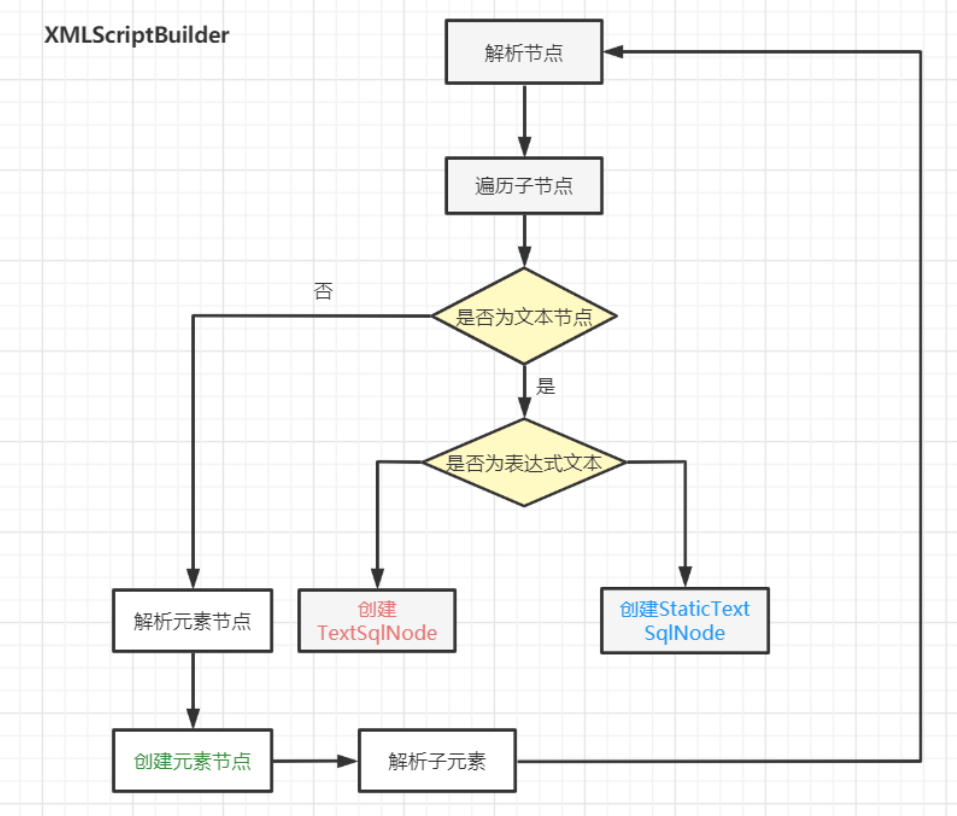
<select id="findActiveBlogLike"
resultType="Blog">
SELECT * FROM BLOG WHERE state = #{ACTIVE}
<choose>
<when test="title != null">
AND title like #{title}
</when>
<when test="author != null and author.name != null">
AND author_name like #{author.name}
</when>
<otherwise>
AND featured = 1
</otherwise>
</choose>
</select>1、XMLLanguageDriver#createSqlSource
创建SqlSource,解析SQL,封装SQL语句(未参数绑定)和入参信息
@Override
public SqlSource createSqlSource(Configuration configuration, XNode script, Class<?> parameterType) {
// 初始化了动态SQL标签处理器
XMLScriptBuilder builder = new XMLScriptBuilder(configuration, script, parameterType);
// 解析动态SQL
return builder.parseScriptNode();
}2、XMLScriptBuilder#构造函数
初始化了动态SQL标签处理器
public XMLScriptBuilder(Configuration configuration, XNode context, Class<?> parameterType) {
super(configuration);
this.context = context;
this.parameterType = parameterType;
// 初始化动态SQL中的节点处理器集合
initNodeHandlerMap();
}3、XMLScriptBuilder#initNodeHandlerMap
初始化动态SQL中的节点处理器集合
private void initNodeHandlerMap() {
nodeHandlerMap.put("trim", new TrimHandler());
nodeHandlerMap.put("where", new WhereHandler());
nodeHandlerMap.put("set", new SetHandler());
nodeHandlerMap.put("foreach", new ForEachHandler());
nodeHandlerMap.put("if", new IfHandler());
nodeHandlerMap.put("choose", new ChooseHandler());
nodeHandlerMap.put("when", new IfHandler());
nodeHandlerMap.put("otherwise", new OtherwiseHandler());
nodeHandlerMap.put("bind", new BindHandler());
}4、XMLScriptBuilder#parseScriptNode
解析动态SQL
public SqlSource parseScriptNode() {
// 解析select\insert\ update\delete标签中的SQL语句,最终将解析到的SqlNode封装到MixedSqlNode中的List集合中
// ****将带有${}号的SQL信息封装到TextSqlNode
// ****将带有#{}号的SQL信息封装到StaticTextSqlNode
// ****将动态SQL标签中的SQL信息分别封装到不同的SqlNode中
MixedSqlNode rootSqlNode = parseDynamicTags(context);
SqlSource sqlSource = null;
// 如果SQL中包含${}和动态SQL语句,则将SqlNode封装到DynamicSqlSource
if (isDynamic) {
sqlSource = new DynamicSqlSource(configuration, rootSqlNode);
} else {
// 如果SQL中包含#{},则将SqlNode封装到RawSqlSource中,并指定parameterType
sqlSource = new RawSqlSource(configuration, rootSqlNode, parameterType);
}
return sqlSource;
}5、XMLScriptBuilder#parseDynamicTags
解析select\insert\ update\delete标签中的SQL语句,最终将解析到的SqlNode封装到MixedSqlNode中的List集合中。
- 将带有${}号的SQL信息封装到TextSqlNode;
- 将带有#{}号的SQL信息封装到StaticTextSqlNode
- 将动态SQL标签中的SQL信息分别封装到不同的SqlNode中
protected MixedSqlNode parseDynamicTags(XNode node) {
List<SqlNode> contents = new ArrayList<>();
//获取<select>\<insert>等4个标签的子节点,子节点包括元素节点和文本节点
NodeList children = node.getNode().getChildNodes();
for (int i = 0; i < children.getLength(); i++) {
XNode child = node.newXNode(children.item(i));
// 处理文本节点
if (child.getNode().getNodeType() == Node.CDATA_SECTION_NODE
|| child.getNode().getNodeType() == Node.TEXT_NODE) {
String data = child.getStringBody("");
// 将文本内容封装到SqlNode中
TextSqlNode textSqlNode = new TextSqlNode(data);
// SQL语句中带有${}的话,就表示是dynamic的
if (textSqlNode.isDynamic()) {
contents.add(textSqlNode);
isDynamic = true;
} else {
// SQL语句中(除了${}和下面的动态SQL标签),就表示是static的
// StaticTextSqlNode的apply只是进行字符串的追加操作
contents.add(new StaticTextSqlNode(data));
}
//处理元素节点
} else if (child.getNode().getNodeType() == Node.ELEMENT_NODE) { // issue #628
String nodeName = child.getNode().getNodeName();
// 动态SQL标签处理器
// 思考,此处使用了哪种设计模式?---策略模式
NodeHandler handler = nodeHandlerMap.get(nodeName);
if (handler == null) {
throw new BuilderException("Unknown element <" + nodeName + "> in SQL statement.");
}
handler.handleNode(child, contents);
// 动态SQL标签是dynamic的
isDynamic = true;
}
}
return new MixedSqlNode(contents);
}6、DynamicSqlSource#构造函数
如果SQL中包含${}和动态SQL语句,则将SqlNode封装到DynamicSqlSource
public DynamicSqlSource(Configuration configuration, SqlNode rootSqlNode) {
this.configuration = configuration;
this.rootSqlNode = rootSqlNode;
}7、RawSqlSource#构造函数
如果SQL中包含#{},则将SqlNode封装到RawSqlSource中,并指定parameterType
private final SqlSource sqlSource;
//先调用 getSql(configuration, rootSqlNode)获取sql,再走下面的构造函数
public RawSqlSource(Configuration configuration, SqlNode rootSqlNode, Class<?> parameterType) {
this(configuration, getSql(configuration, rootSqlNode), parameterType);
}
public RawSqlSource(Configuration configuration, String sql, Class<?> parameterType) {
// 解析SQL语句
SqlSourceBuilder sqlSourceParser = new SqlSourceBuilder(configuration);
// 获取入参类型
Class<?> clazz = parameterType == null ? Object.class : parameterType;
// 开始解析
sqlSource = sqlSourceParser.parse(sql, clazz, new HashMap<String, Object>());
}
private static String getSql(Configuration configuration, SqlNode rootSqlNode) {
DynamicContext context = new DynamicContext(configuration, null);
rootSqlNode.apply(context);
return context.getSql();
}SqlSourceBuilder#parse
解析SQL语句
public SqlSource parse(String originalSql, Class<?> parameterType, Map<String, Object> additionalParameters) {
ParameterMappingTokenHandler handler = new ParameterMappingTokenHandler(configuration, parameterType,
additionalParameters);
// 创建分词解析器
GenericTokenParser parser = new GenericTokenParser("#{", "}", handler);
// 解析#{}
String sql = parser.parse(originalSql);
// 将解析之后的SQL信息,封装到StaticSqlSource对象中
// SQL字符串是带有?号的字符串,?相关的参数信息,封装到ParameterMapping集合中
return new StaticSqlSource(configuration, sql, handler.getParameterMappings());
}ParameterMappingTokenHandler#构造函数
public ParameterMappingTokenHandler(Configuration configuration, Class<?> parameterType,Map<String, Object> additionalParameters) {
super(configuration);
this.parameterType = parameterType;
this.metaParameters = configuration.newMetaObject(additionalParameters);
}GenericTokenParser#构造函数
创建分词解析器,指定待分析的openToken和closeToken,并指定处理器
public GenericTokenParser(String openToken, String closeToken, TokenHandler handler) {
this.openToken = openToken;
this.closeToken = closeToken;
this.handler = handler;
}GenericTokenParser#parse
解析SQL语句,处理openToken和closeToken中的内容
/**
* 解析${}和#{}
* @param text
* @return
*/
public String parse(String text) {
if (text == null || text.isEmpty()) {
return "";
}
// search open token
int start = text.indexOf(openToken, 0);
if (start == -1) {
return text;
}
char[] src = text.toCharArray();
int offset = 0;
final StringBuilder builder = new StringBuilder();
StringBuilder expression = null;
while (start > -1) {
if (start > 0 && src[start - 1] == '\\') {
// this open token is escaped. remove the backslash and continue.
builder.append(src, offset, start - offset - 1).append(openToken);
offset = start + openToken.length();
} else {
// found open token. let's search close token.
if (expression == null) {
expression = new StringBuilder();
} else {
expression.setLength(0);
}
builder.append(src, offset, start - offset);
offset = start + openToken.length();
int end = text.indexOf(closeToken, offset);
while (end > -1) {
if (end > offset && src[end - 1] == '\\') {
// this close token is escaped. remove the backslash and continue.
expression.append(src, offset, end - offset - 1).append(closeToken);
offset = end + closeToken.length();
end = text.indexOf(closeToken, offset);
} else {
expression.append(src, offset, end - offset);
offset = end + closeToken.length();
break;
}
}
if (end == -1) {
// close token was not found.
builder.append(src, start, src.length - start);
offset = src.length;
} else {
builder.append(handler.handleToken(expression.toString()));
offset = end + closeToken.length();
}
}
start = text.indexOf(openToken, offset);
}
if (offset < src.length) {
builder.append(src, offset, src.length - offset);
}
return builder.toString();
}ParameterMappingTokenHandler#handleToken
处理token(#{}/${})
@Override
public String handleToken(String content) {
parameterMappings.add(buildParameterMapping(content));
return "?";
}ParameterMappingTokenHandler#buildParameterMapping
创建ParameterMapping对象
private ParameterMapping buildParameterMapping(String content) {
Map<String, String> propertiesMap = parseParameterMapping(content);
String property = propertiesMap.get("property");
Class<?> propertyType;
if (metaParameters.hasGetter(property)) { // issue #448 get type from additional params
propertyType = metaParameters.getGetterType(property);
} else if (typeHandlerRegistry.hasTypeHandler(parameterType)) {
propertyType = parameterType;
} else if (JdbcType.CURSOR.name().equals(propertiesMap.get("jdbcType"))) {
propertyType = java.sql.ResultSet.class;
} else if (property == null || Map.class.isAssignableFrom(parameterType)) {
propertyType = Object.class;
} else {
MetaClass metaClass = MetaClass.forClass(parameterType, configuration.getReflectorFactory());
if (metaClass.hasGetter(property)) {
propertyType = metaClass.getGetterType(property);
} else {
propertyType = Object.class;
}
}
ParameterMapping.Builder builder = new ParameterMapping.Builder(configuration, property, propertyType);
Class<?> javaType = propertyType;
String typeHandlerAlias = null;
for (Map.Entry<String, String> entry : propertiesMap.entrySet()) {
String name = entry.getKey();
String value = entry.getValue();
if ("javaType".equals(name)) {
javaType = resolveClass(value);
builder.javaType(javaType);
} else if ("jdbcType".equals(name)) {
builder.jdbcType(resolveJdbcType(value));
} else if ("mode".equals(name)) {
builder.mode(resolveParameterMode(value));
} else if ("numericScale".equals(name)) {
builder.numericScale(Integer.valueOf(value));
} else if ("resultMap".equals(name)) {
builder.resultMapId(value);
} else if ("typeHandler".equals(name)) {
typeHandlerAlias = value;
} else if ("jdbcTypeName".equals(name)) {
builder.jdbcTypeName(value);
} else if ("property".equals(name)) {
// Do Nothing
} else if ("expression".equals(name)) {
throw new BuilderException("Expression based parameters are not supported yet");
} else {
throw new BuilderException("An invalid property '" + name + "' was found in mapping #{" + content
+ "}. Valid properties are " + parameterProperties);
}
}
if (typeHandlerAlias != null) {
builder.typeHandler(resolveTypeHandler(javaType, typeHandlerAlias));
}
return builder.build();
}StaticSqlSource#构造函数
将解析之后的SQL信息,封装到StaticSqlSource
private final String sql;
private final List<ParameterMapping> parameterMappings;
private final Configuration configuration;
public StaticSqlSource(Configuration configuration, String sql) {
this(configuration, sql, null);
}
public StaticSqlSource(Configuration configuration, String sql, List<ParameterMapping> parameterMappings) {
this.sql = sql;
this.parameterMappings = parameterMappings;
this.configuration = configuration;
}六、SqlSession执行流程(重)
1、相关类与接口
DefaultSqlSession:SqlSession接口的默认实现类Executor接口

BaseExecutor:基础执行器,封装了子类的公共方法,包括一级缓存、延迟加载、回滚、关闭等功能;SimpleExecutor:简单执行器,每执行一条 sql,都会打开一个Statement,执行完成后关闭;ReuseExecutor:重用执行器,相较于SimpleExecutor多了Statement的缓存功能,其内部维护一个Map<String, Statement>,每次编译完成的Statement都会进行缓存,不会关闭;BatchExecutor:批量执行器,基于 JDBC 的addBatch、executeBatch功能,并且在当前 sql 和上一条 sql 完全一样的时候,重用 Statement,在调用doFlushStatements的时候,将数据刷新到数据库;CachingExecutor:缓存执行器,装饰器模式,在开启缓存的时候。会在上面三种执行器的外面包上CachingExecutor;
StatementHandler接口:是四大组件中最重要的一个对象,负责操作 Statement 对象与数据库进行交流,在工作时还会使用 ParameterHandler 和 ResultSetHandler 对参数进行映射,对结果进行实体类的绑定
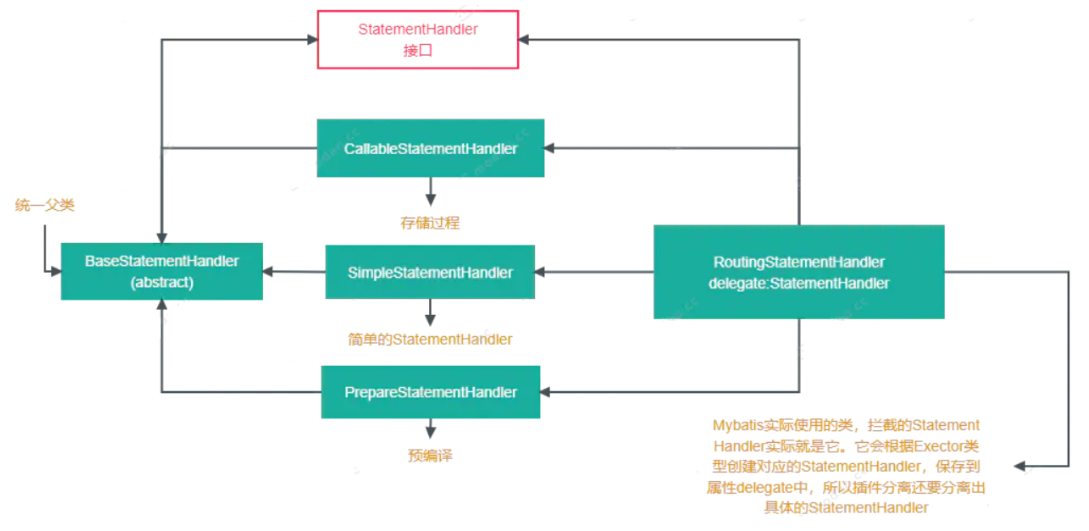
RoutingStatementHandler:路由。Mybatis实际使用的类,拦截的StatementHandler实际就是它。它会根据Exector类型创建对应的StatementHandler,保存到属性delegate中PreparedStatementHandler:预编译StatementResultSetHandler接口:处理Statement执行后产生的结果集,生成结果列表;处理存储过程执行后的输出参数DefaultResultSetHandler:ResultSetHandler的默认实现类
2、流程图
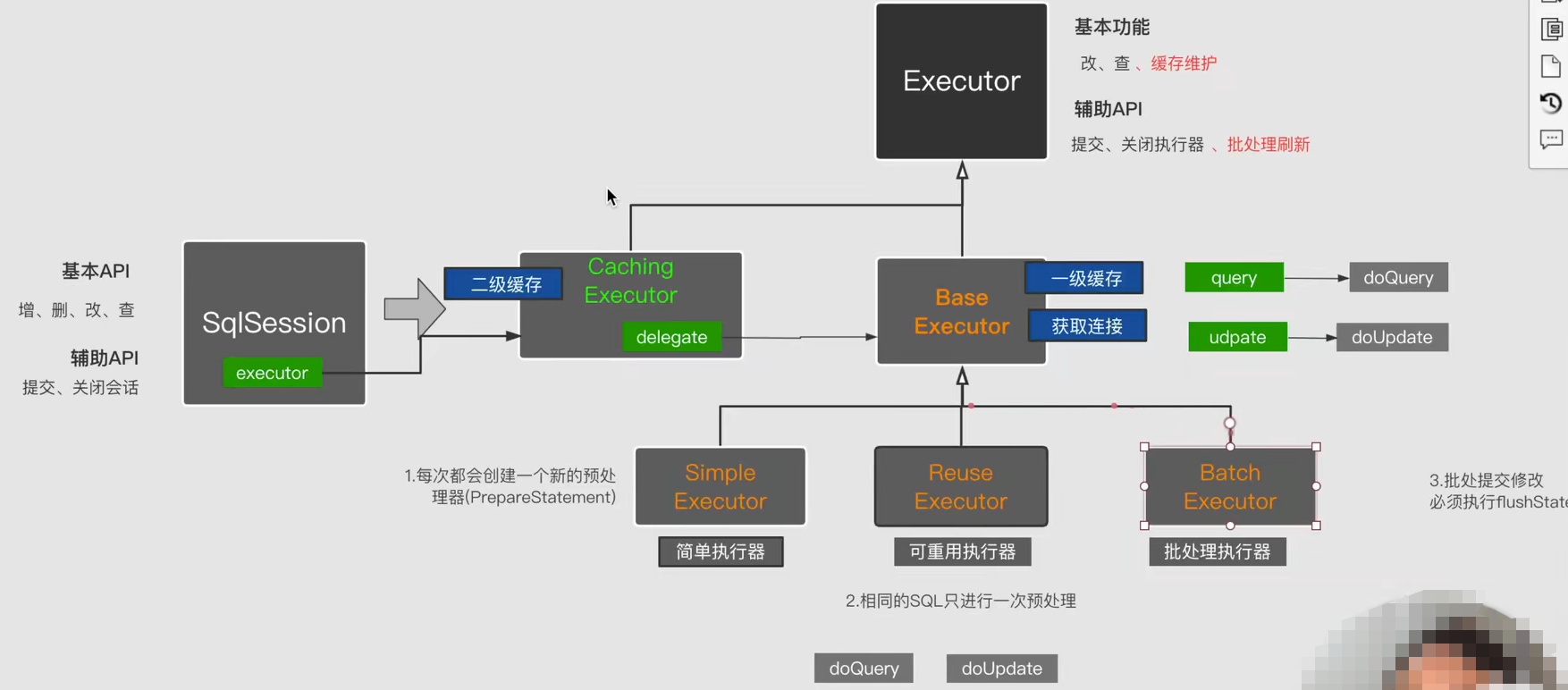
1、SqlSession (sql 会话)是实现了门面模式,提供一个统一的接口去实现增删改查,具体的由子类实现
2、SqlSession 中的成员变量 executor 是具体实现增删改查操作的执行器(CachingExecutor)
3、CachingExecutor 主要是实现二级缓存的操作,如果二级缓存没查到,则转交 delegate
4、CachingExecutor 中的成员变量 delegate 实现装饰者模式,delegate 是查询一级缓存和数据库的具体实现,CachingExecutor 是对于 三种 BaseExecutor 子类的功能扩展(二级缓存)
5、当 CachingExecutor 中二级缓存查不到数据时,会委派 delegate (具体执行器)去查询一级缓存或数据库
3、流程分析
(1)DefaultSqlSession#selectList(入口)
@Override
public <E> List<E> selectList(String statement, Object parameter, RowBounds rowBounds) {
try {
// 根据传入的statementId,获取MappedStatement对象
MappedStatement ms = configuration.getMappedStatement(statement);
// 调用执行器的查询方法
// RowBounds是用来逻辑分页(按照条件将数据从数据库查询到内存中,在内存中进行分页)
// wrapCollection(parameter)是用来装饰集合或者数组参数
return executor.query(ms, wrapCollection(parameter), rowBounds, Executor.NO_RESULT_HANDLER);
} catch (Exception e) {
throw ExceptionFactory.wrapException("Error querying database. Cause: " + e, e);
} finally {
ErrorContext.instance().reset();
}
}(2)CachingExecutor#query
Configuration 中 cacheEnabled 属性值默认为true
//第一步
@Override
public <E> List<E> query(MappedStatement ms, Object parameterObject, RowBounds rowBounds, ResultHandler resultHandler) throws SQLException {
// 获取绑定的SQL语句,比如“SELECT * FROM user WHERE id = ? ”
BoundSql boundSql = ms.getBoundSql(parameterObject);
// 将 sql 语句的信息封装到 CacheKey 中, 在查询二级缓存时,使用该对象作为key
CacheKey key = createCacheKey(ms, parameterObject, rowBounds, boundSql);
return query(ms, parameterObject, rowBounds, resultHandler, key, boundSql);
}
//第二步
@Override
public <E> List<E> query(MappedStatement ms, Object parameterObject, RowBounds rowBounds, ResultHandler resultHandler, CacheKey key, BoundSql boundSql)
throws SQLException {
// 获取二级缓存
Cache cache = ms.getCache();
if (cache != null) {
// 当为select语句时,flushCache默认为false,表示任何时候语句被调用,都不会去清空本地缓存和二级缓存
// 当为insert、update、delete语句时,useCache默认为true,表示会将本条语句的结果进行二级缓存
// 刷新二级缓存 (存在缓存且flushCache为true时)
flushCacheIfRequired(ms);
if (ms.isUseCache() && resultHandler == null) {
ensureNoOutParams(ms, boundSql);
// 从二级缓存中查询数据
// TransactionalCacheManager,二级缓存管理器,缓存数据再起成员变量中
//成员变量Map<Cache, TransactionalCache> transactionalCaches
@SuppressWarnings("unchecked")
List<E> list = (List<E>) tcm.getObject(cache, key);
// 如果二级缓存中没有查询到数据,则查询一级缓存或数据库
if (list == null) {
// 委托给BaseExecutor执行
list = delegate.query(ms, parameterObject, rowBounds, resultHandler, key, boundSql);
tcm.putObject(cache, key, list); // issue #578 and #116
}
return list;
}
}
// 委托给BaseExecutor执行
return delegate.query(ms, parameterObject, rowBounds, resultHandler, key, boundSql);
}(3)BaseExecutor#query
二级缓存设置开启且缓存中没有或者未开启二级缓存,则从一级缓存中查找结果集
@Override
public <E> List<E> query(MappedStatement ms, Object parameter, RowBounds rowBounds, ResultHandler resultHandler, CacheKey key, BoundSql boundSql) throws SQLException {
ErrorContext.instance().resource(ms.getResource()).activity("executing a query").object(ms.getId());
if (closed) {
throw new ExecutorException("Executor was closed.");
}
if (queryStack == 0 && ms.isFlushCacheRequired()) {
clearLocalCache();
}
List<E> list;
try {
queryStack++;
// 从一级缓存中获取数据
list = resultHandler == null ? (List<E>) localCache.getObject(key) : null;
if (list != null) {
handleLocallyCachedOutputParameters(ms, key, parameter, boundSql);
} else {
// 如果一级缓存没有数据,则从数据库查询数据
list = queryFromDatabase(ms, parameter, rowBounds, resultHandler, key, boundSql);
}
} finally {
queryStack--;
}
if (queryStack == 0) {
for (DeferredLoad deferredLoad : deferredLoads) {
deferredLoad.load();
}
// issue #601
deferredLoads.clear();
if (configuration.getLocalCacheScope() == LocalCacheScope.STATEMENT) {
// issue #482
clearLocalCache();
}
}
return list;
} (4)BaseExecutor#queryFromDatabase
如果一级缓存没有数据,则从数据库查询数据
private <E> List<E> queryFromDatabase(MappedStatement ms, Object parameter, RowBounds rowBounds, ResultHandler resultHandler, CacheKey key, BoundSql boundSql) throws SQLException {
List<E> list;
// 先为这个 key 设置一个一级缓存占位符
localCache.putObject(key, EXECUTION_PLACEHOLDER);
try {
// 执行查询
list = doQuery(ms, parameter, rowBounds, resultHandler, boundSql);
} finally {
//移除一级缓存中原有值
localCache.removeObject(key);
}
//往一级缓存中存值
localCache.putObject(key, list);
if (ms.getStatementType() == StatementType.CALLABLE) {
localOutputParameterCache.putObject(key, parameter);
}
return list;
}(5)SimpleExecutor#doQuery

BaseStatementHandler:基础语句处理器(抽象类),它基本把语句处理器接口的核心部分都实现了,包括配置绑定、执行器绑定、映射器绑定、参数处理器构建、结果集处理器构建、语句超时设置、语句关闭等,并另外定义了新的方法 instantiateStatement 供不同子类实现以便获取不同类型的语句连接,子类可以普通执行 SQL 语句,也可以做预编译执行,还可以执行存储过程等。
SimpleStatementHandler:普通语句处理器,继承 BaseStatementHandler 抽象类,对应 java.sql.Statement 对象的处理,处理普通的不带动态参数运行的 SQL,即执行简单拼接的字符串语句,同时由于 Statement 的特性,SimpleStatementHandler 每次执行都需要编译 SQL (注意:我们知道 SQL 的执行是需要编译和解析的)。
PreparedStatementHandler:预编译语句处理器,继承 BaseStatementHandler 抽象类,对应 java.sql.PrepareStatement 对象的处理,相比上面的普通语句处理器,它支持可变参数 SQL 执行,由于 PrepareStatement 的特性,它会进行预编译,在缓存中一旦发现有预编译的命令,会直接解析执行,所以减少了再次编译环节,能够有效提高系统性能,并预防 SQL 注入攻击(所以是系统默认也是我们推荐的语句处理器)。
CallableStatementHandler:存储过程处理器,继承 BaseStatementHandler 抽象类,对应 java.sql.CallableStatement 对象的处理,很明了,它是用来调用存储过程的,增加了存储过程的函数调用以及输出/输入参数的处理支持。
RoutingStatementHandler:路由语句处理器,直接实现了 StatementHandler 接口,作用如其名称,确确实实只是起到了路由功能,并把上面介绍到的三个语句处理器实例作为自身的委托对象而已,所以执行器在构建语句处理器时,都是直接 new 了 RoutingStatementHandler 实例。
执行查询
@Override
public <E> List<E> doQuery(MappedStatement ms, Object parameter, RowBounds rowBounds, ResultHandler resultHandler,
BoundSql boundSql) throws SQLException {
Statement stmt = null;
try {
// 获取Configuration对象
Configuration configuration = ms.getConfiguration();
// 创建RoutingStatementHandler,用来处理Statement
// RoutingStatementHandler类中初始化delegate类(SimpleStatementHandler、PreparedStatementHandler)
StatementHandler handler = configuration.newStatementHandler(wrapper, ms, parameter, rowBounds,
resultHandler, boundSql);
// 子流程1:设置参数
stmt = prepareStatement(handler, ms.getStatementLog());
// 子流程2:执行SQL语句(已经设置过参数),并且映射结果集
return handler.query(stmt, resultHandler);
} finally {
closeStatement(stmt);
}
}SimpleExecutor#prepareStatement
创建StatementHandler,用来执行MappedStatement对象
ublic StatementHandler newStatementHandler(Executor executor,
MappedStatement mappedStatement,
Object parameterObject,
RowBounds rowBounds,
ResultHandler resultHandler,
BoundSql boundSql) {
// 创建路由功能的StatementHandler,根据MappedStatement中的StatementType
StatementHandler statementHandler =
new RoutingStatementHandler(executor,
mappedStatement,
parameterObject,
rowBounds,
resultHandler,
boundSql);
// 设置拦截器链(插件的实现)
statementHandler =(StatementHandler) interceptorChain.pluginAll(statementHandler);
return statementHandler;
}RoutingStatementHandler#构造函数
创建路由功能的StatementHandler,根据MappedStatement中的StatementType
public RoutingStatementHandler(Executor executor, MappedStatement ms, Object parameter, RowBounds rowBounds, ResultHandler resultHandler, BoundSql boundSql) {
switch (ms.getStatementType()) {
case STATEMENT:
delegate = new SimpleStatementHandler(executor, ms, parameter, rowBounds, resultHandler, boundSql);
break;
case PREPARED:
delegate = new PreparedStatementHandler(executor, ms, parameter, rowBounds, resultHandler, boundSql);
break;
case CALLABLE:
delegate = new CallableStatementHandler(executor, ms, parameter, rowBounds, resultHandler, boundSql);
break;
default:
throw new ExecutorException("Unknown statement type: " + ms.getStatementType());
}
}(6)SimpleExecutor#prepareStatement
private Statement prepareStatement(StatementHandler handler, Log statementLog) throws SQLException {
Statement stmt;
// 获取连接
Connection connection = getConnection(statementLog);
// 创建Statement(PreparedStatement、Statement、CallableStatement)
stmt = handler.prepare(connection, transaction.getTimeout());
// SQL参数设置
handler.parameterize(stmt);
return stmt;
}(7)参数设置:PreparedStatementHandler#parameterize
@Override
public void parameterize(Statement statement) throws SQLException {
// 通过ParameterHandler处理参数
parameterHandler.setParameters((PreparedStatement) statement);
}(8)执行sql:PreparedStatementHandler#query
执行SQL语句(已经设置过参数),并且映射结果集
@Override
public <E> List<E> query(Statement statement, ResultHandler resultHandler) throws SQLException {
PreparedStatement ps = (PreparedStatement) statement;
// 执行PreparedStatement,也就是调用 JDBC 的 api 执行SQL语句
ps.execute();
// 处理结果集
return resultSetHandler.handleResultSets(ps);
}(9)处理结果集DefaultResultSetHandler#handleResultSets
@Override
public List<Object> handleResultSets(Statement stmt) throws SQLException {
ErrorContext.instance().activity("handling results").object(mappedStatement.getId());
// <select>标签的resultMap属性,可以指定多个值,多个值之间用逗号(,)分割
final List<Object> multipleResults = new ArrayList<>();
int resultSetCount = 0;
// 这里是获取第一个结果集,将传统JDBC的ResultSet包装成一个包含结果列元信息的ResultSetWrapper对象
ResultSetWrapper rsw = getFirstResultSet(stmt);
// 这里是获取所有要映射的ResultMap(按照逗号分割出来的)
List<ResultMap> resultMaps = mappedStatement.getResultMaps();
// 要映射的ResultMap的数量
int resultMapCount = resultMaps.size();
validateResultMapsCount(rsw, resultMapCount);
// 循环处理每个ResultMap,从第一个开始处理
while (rsw != null && resultMapCount > resultSetCount) {
// 得到结果映射信息
ResultMap resultMap = resultMaps.get(resultSetCount);
// 处理结果集
// 从rsw结果集参数中获取查询结果,再根据resultMap映射信息,将查询结果映射到multipleResults中
handleResultSet(rsw, resultMap, multipleResults, null);
rsw = getNextResultSet(stmt);
cleanUpAfterHandlingResultSet();
resultSetCount++;
}
// 对应<select>标签的resultSets属性,一般不使用该属性
String[] resultSets = mappedStatement.getResultSets();
if (resultSets != null) {
while (rsw != null && resultSetCount < resultSets.length) {
ResultMapping parentMapping = nextResultMaps.get(resultSets[resultSetCount]);
if (parentMapping != null) {
String nestedResultMapId = parentMapping.getNestedResultMapId();
ResultMap resultMap = configuration.getResultMap(nestedResultMapId);
handleResultSet(rsw, resultMap, null, parentMapping);
}
rsw = getNextResultSet(stmt);
cleanUpAfterHandlingResultSet();
resultSetCount++;
}
}
// 如果只有一个结果集合,则直接从多结果集中取出第一个
return collapseSingleResultList(multipleResults);
}
